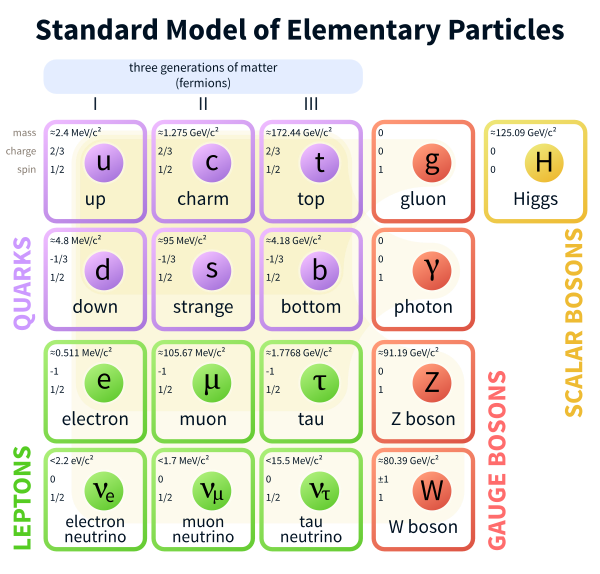 In particle physics, an elementary particle or fundamental particle is a particle whose substructure is unknown; thus, it is unknown whether it is composed of other particles.[1] Known elementary particles include the fundamental fermions (quarks, leptons, antiquarks, and antileptons), which generally are "matter particles" and "antimatter particles", as well as the fundamental bosons (gauge bosons and the Higgs boson), which generally are "force particles" that mediate interactions among fermions.[1] A particle containing two or more elementary particles is a composite particle.
In particle physics, an elementary particle or fundamental particle is a particle whose substructure is unknown; thus, it is unknown whether it is composed of other particles.[1] Known elementary particles include the fundamental fermions (quarks, leptons, antiquarks, and antileptons), which generally are "matter particles" and "antimatter particles", as well as the fundamental bosons (gauge bosons and the Higgs boson), which generally are "force particles" that mediate interactions among fermions.[1] A particle containing two or more elementary particles is a composite particle.
Everyday matter is composed of atoms, once presumed to be matter's elementary particles—atom meaning "unable to cut" in Greek—although the atom's existence remained controversial until about 1910, as some leading physicists regarded molecules as mathematical illusions, and matter as ultimately composed of energy.[1][2] Soon, subatomic constituents of the atom were identified. As the 1930s opened, the electron and the proton had been observed, along with the photon, the particle of electromagnetic radiation.[1] At that time, the recent advent of quantum mechanics was radically altering the conception of particles, as a single particle could seemingly span a field as would a wave, a paradox still eluding satisfactory explanation.[3][4][5]
Via quantum theory, protons and neutrons were found to contain quarks—up quarks and down quarks—now considered elementary particles.[1] And within a molecule, the electron's three degrees of freedom (charge, spin, orbital) can separate via the wavefunction into three quasiparticles (holon, spinon, orbiton).[6] Yet a free electron—which is not orbiting an atomic nucleus and lacks orbital motion—appears unsplittable and remains regarded as an elementary particle.[6]
Around 1980, an elementary particle's status as indeed elementary—an ultimate constituent of substance—was mostly discarded for a more practical outlook,[1] embodied in particle physics' Standard Model, what's known as science's most experimentally successful theory.[5][7] Many elaborations upon and theories beyond the Standard Model, including the popular supersymmetry, double the number of elementary particles by hypothesizing that each known particle associates with a "shadow" partner far more massive,[8][9] although all such superpartners remain undiscovered.[7][10] Meanwhile, an elementary boson mediating gravitation—the graviton—remains hypothetical.
Hi! I am a robot. I just upvoted you! I found similar content that readers might be interested in:
https://broom02.revolvy.com/topic/Elementary%20particle